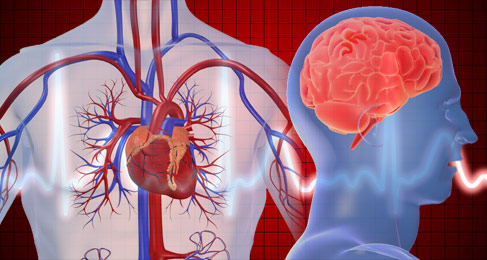Difference between stroke and heart attack is very big, but both are dangerous conditions. Both a stroke (and "brain attack") and a heart attack can result in death if not treated properly. It is, therefore, important to recognize the symptoms of these conditions if you or a loved one comes down with them because there are treatments that can improve the chance of survival and lessen disability if given promptly.

Difference Between Stroke and Heart Attack
Both a heart attack and stroke represent medical issues of the circulatory system. Both involve narrowed arteries that develop blood clots which stop the flow of blood to an important part of the body. When this happens there is cell death and a loss of organ function. Even so, the organs are different and the symptoms you get from each of them are completely different.
1. Definitions
Stroke is a narrowing and subsequent blockage of one or more arteries which supply the blood to the brain. If a clot forms in the narrowed arteries, the part of the brain supplied by the artery dies. When it comes to strokes, you should know that there are two kinds.
- The first is an ischemic stroke, in which blood flow is interrupted to the brain. This is about 80 percent of all strokes.
- The second is a hemorrhagic stroke, which is due to the bleeding inside or around the brain. This represents 20 percent of all strokes. Hemorrhagic strokes tend to be more dangerous than are ischemic strokes.
A heart attack involves damage to heart muscle, which dies off because of a reduction in blood flow. Usually, a blood clot develops in one of the coronary arteries that supply blood flow to the heart muscle.
2. Causes
Strokes are related to hypertension and a gradual reduction in the size of the lumen of the arteries to the brain.A stroke can also be caused by fatty material, blood clots, cancer cells, bacteria, or air bubbles that arise elsewhere in the brain and travel through the blood to become lodged in the arteries to the brain.
Meanwhile, the majority of heart attacks are the result of coronary artery disease, which involves a gradual reduction in the size of the lumen of arteries leading to (or inside) the heart. Risk factors include obesity, smoking, and a sedentary lifestyle.
3. Symptoms
The symptoms of a stroke include a dim vision or sudden loss of vision, a sudden weakness in one side of the body or in the face, numbness of a body area, difficulty swallowing, a sudden, severe headache, sudden falls, or a short period of loss of consciousness.
The symptoms of a heart attack are different. The main symptoms include chest pain or discomfort in the chest that feels like a weight is on your chest. The pain can radiate from the chest to the jaw, stomach, back, left shoulder, or arms. You can have irregular heartbeats, shortness of breath, indigestion or symptoms similar to heartburn, dizziness or light-headedness, cold sweats, nausea or vomiting, or a sensation of anxiety or marked weakness.
The symptom of both can occur quite quickly, so if you or someone you are with shows any of the above signs, they are not to be ignored. Instead, dial 911 in order to call an ambulance for emergency aid, even if you are not completely sure you are having a stroke or a heart attack.
More explanation from experts:
4. Treatments
Treatment similarity and difference between stroke and heart attack is:
For Stroke
The treatment of a stroke can depend on what type of stroke you are experiencing.
If you are having an ischemic stroke, the focus of treatment is on opening up the blood vessels leading to the brain. This can involve giving aspirin, which is a platelet inhibitor, and an IV infusion of a clot buster known as tissue plasminogen activator or TPA. TPA can effectively dissolve clots but must be given within 4 ½ hours from the onset of symptom so that cell death can be avoided. Surgery can be done to diminish the chances of having another stroke. This type of surgery is called a carotid endarterectomy. In this surgery, a surgeon opens up the affected artery and removes the offending plaque from the artery. Angioplasty can also be performed, in which the surgeon passes a catheter with a small balloon into the area of narrowing and blows up the balloon, thus giving more room for blood to flow.
Hemorrhagic strokes are treated differently. Here, the main focus is on reducing the blood pressure inside the brain and stopping the bleeding. The usual treatment involves giving medications to reduce the blood pressure in the brain and to prevent seizures. Surgery can also be used to deal with weakened areas of the blood vessels in the brain.
For Heart Attack
There is a difference between stroke and heart attack, but the treatment is similar. The main goal of treating a heart attack is to keep platelets from forming a clot on the arterial wall plaque. Medications are urgently necessary to lessen the degree of heart damage and this means giving the medications within 1-2 hours after the heart attack symptoms begin. The most common medications used to treat a heart attack are anti-platelet drugs like aspirin, Plavix, and TPA, which act as a clot buster to break up the clot contributing to the lack of blood flow to the heart.
In addition, the doctor may choose to do an emergency angioplasty with stent placement. This involves putting a catheter in the blood vessels that are blocked and opening them up with a balloon, in the end, placing a stent or metal cage inside the artery to prevent the artery from closing again.
